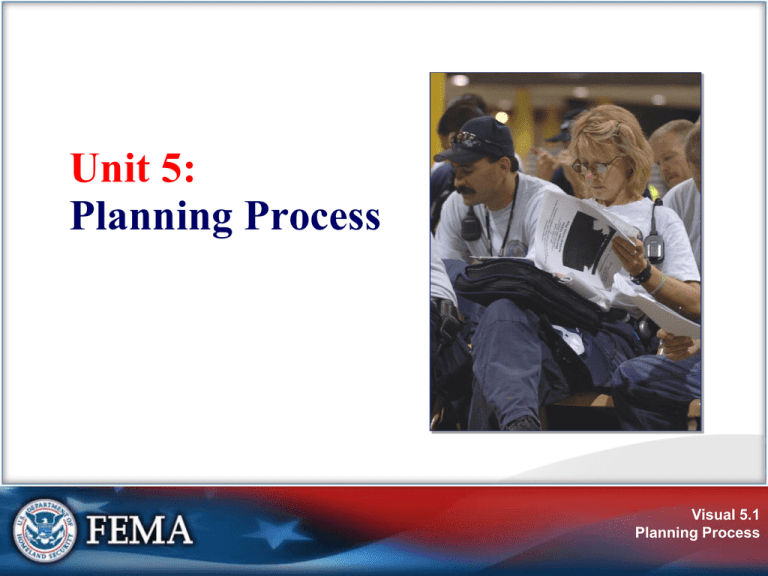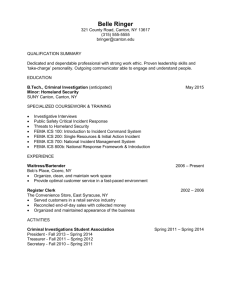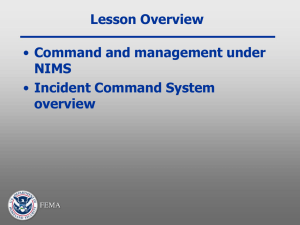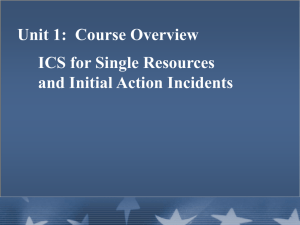panko unit 5 plannin.. - Risky Business Incident Management LLC
advertisement

Unit 5: Planning Process Visual 5.1 Planning Process Unit Objectives (1 of 3) Identify the importance of planning for incidents/events. Explain the differences between planning for incidents and events. Discuss major planning steps including logistical concerns, cost-benefit analysis, understanding the situation, developing and implementing the plan, and evaluating the plan. Explain the criteria for determining when the Incident Action Plan (IAP) should be prepared in writing. Visual 5.2 Planning Process Unit Objectives (2 of 3) Describe the role and use of ICS forms and supporting materials included in an IAP for effective incident/event management. Describe the strategy meeting, tactics meeting, planning meeting, operational period briefing, and team meeting. Given a scenario, describe appropriate strategies and tactics to meet incident objectives. Conduct a tactics meeting and complete an ICS 215, Operational Planning Worksheet, and ICS 215A, Incident Action Plan Safety Analysis, using the strategies and tactics from the scenario. Visual 5.3 Planning Process Unit Objectives (3 of 3) Describe how ICS 215A is used with ICS 215 to mitigate hazards in tactical operations. Recognize agency-specific aviation policies and procedures as they relate to safety. Participate in a planning meeting using the planning process and develop a written IAP for an incident/event using the appropriate ICS forms and supporting materials. Using the IAP, conduct an operational period briefing. Visual 5.4 Planning Process Benefits of the Planning Process What are the benefits of the incident planning process? Visual 5.5 Planning Process ICS Planning Process Visual 5.6 Planning Process Written IAP Considered What are the situations when you would consider developing a written Incident Action Plan? Visual 5.7 Planning Process When a Written IAP Is Considered Two or more jurisdictions are involved in the response. The incident continues into the next operational period. A number of ICS organizational elements are activated (typically when General Staff Sections are staffed). It is required by agency policy. It is a hazmat incident. Visual 5.8 Planning Process What’s an Operational Period? The designated time period in which tactical objectives are to be accomplished and reevaluated. Length depends on: Nature of incident Complexity Visual 5.9 Planning Process Who Does What? Visual 5.10 Planning Process The Start of Each Planning Cycle Planning for each operational period begins with the Incident Commander or Unified Command developing/ updating incident objectives. Objectives are based on the continued assessment of the situation and the progress made. Visual 5.11 Planning Process Assessing Current Objectives Is the incident stable, or is it increasing in size and complexity? What are the current incident objectives, strategy, and tactics? Are there any safety issues? Are the objectives effective? Is a change of course needed? How long will it be until the objectives are completed? What is the current status of resources? Are resources in good condition? Are there sufficient resources? Visual 5.12 Planning Process The Tactics Meeting: Overview Purpose Preparation Who Attends Who Leads Visual 5.13 Planning Process Objectives, Strategies, and Tactics State what will be accomplished. Establish the general plan or direction for accomplishing the incident objectives. Specify how the strategies will be executed. Visual 5.14 Planning Process Developing Appropriate Strategy Generate a list of alternative strategies. Select the strategy that: Is within acceptable safety norms. Makes good sense (is feasible, practical, and suitable). Is cost effective. Is consistent with sound environmental practices. Meets political considerations. Visual 5.15 Planning Process Planning . . . Who Really Develops Tactics to Meet the Strategy/Objectives Operations Section Chief What is going on here prior to the Tactics Meeting? Division Supervisors Unit 6: Planning Process Visual 6.16 Executing Tactical Direction Establish Tactics: Describe what must be done. Assign Resources: Determine and assign the kind and type of resources needed for the selected tactics. Monitor Performance: Determine if the tactics and resources selected for the various strategies are both valid and adequate. Visual 5.17 Planning Process Sample Strategy and Tactics Objective: Reduce reservoir level to 35 feet by 0800 on 2/10. Strategy #1: Reduce/divert inflow. Strategy #2: Release water from spillways. Selected Strategy: Pump water from reservoir. Tactics: Use truck-mounted pumps working from the road into spillway, and portable pumps on the east side discharging into Murkey Creek. Resources: 5 crews with (3) 1,500-gpm truck-mounted pumps & (2) 500-gpm portable pumps Visual 5.18 Planning Process Logistics Support Factors Why must personnel and logistical support factors be considered in determining tactical operations? Visual 5.19 Planning Process Cost-Benefit Analysis What are some factors that you consider when assessing the costs and benefits of proposed tactical assignments? Visual 5.20 Planning Process Tactics Meeting Documentation Operational Planning Worksheet, ICS Form 215 Visual 5.21 Planning Process Visual 5.22 Planning Process Visual 5.23 Planning Process Incident Safety Incident management must ensure the safety of: Responders to the incident. Persons injured or threatened by the incident. Volunteers assisting at the incident. News media and the general public who are on scene observing the incident. Visual 5.24 Planning Process Incident Safety Analysis The Incident Safety Analysis is used to: Identify, prioritize, and mitigate the hazards and risks of each incident work location by operational period. Identify hazardous tactics so that alternatives may be considered. Determine the safety implications for the types of resources required. Visual 5.25 Planning Process ICS Form 215A, Incident Action Plan Safety Analysis The Safety Officer and Operations Section Chief complete the Safety Analysis using ICS 215A for . . . Visual 5.26 Planning Process Aviation Safety Does your agency have aviation safety policies and procedures? Visual 5.27 Planning Process Preparing for the Planning Meeting This is final prep before Planning Meeting. Operations SC will assess current operations effectiveness and achievements and update the 215 if needed. Logistics SC will determine if outstanding orders will be filled in time for next operational period. Vet out issues so “no surprises” . Based on the above finalize the ICS 215 developed during the tactics meeting making certain the 215 presented in the Planning Meeting reflects reality with what Resources & Assignments you will have for next operational period. Finalize the Incident Action Plan Safety Analysis (ICS 215A) completed by the Safety Officer & Operations SC. Visual 5.28 Planning Process The Planning Meeting Purposes: Review/validate Operations proposed plan; describe work assignments & resources assigned; verify all C&G members can support Operations proposed plan. Who Attends: Command and General Staffs, other incident management personnel, Agency Administrator, and cooperating/assisting agency personnel Who Leads: Planning Section Chief Visual 5.29 Planning Process Planning Meeting Agenda & Facts •Current Situation •Objectives •Predictive Information •Assignments •Safety •Logistics •Finance •Planning •Information •Liaison •Agency Reps / Agency Administrator •Close Out •During the “Preparing for the Planning Meeting” step of the Planning P issues should have been vetted out so when the plan for the next Operational Period is presented their should be “no surprises”. •We use the same logical agenda that we have used for the Operational Period Briefing to conduct our Planning Meetings •Remember the difference of purpose of “Briefings” and “Meetings”. They are distinctly different and have different audiences • The purpose of the Planning Meeting is for the Operations Section Chief to present their plan for the next operational period to the full C&G staff and confirm their support of that plan. •The OSC is not asked if they can support the plan since it is, after all, their plan. AREPs and Agency Admins may be there as well. •The plan presented at the Planning Meeting & supported at the Planning Meeting is the IAP we publish Visual 5.30 Planning Process Planning Meeting Activities Responsibility Give situation & resources briefing; conduct planning meeting Planning Section Chief State incident objectives & policy issues Incident Commander State primary & alternative strategies to meet objectives Operations Section Chief; Planning/Logistics Section Chiefs contribute Specify reporting locations & additional facilities needed Operations Section Chief; Logistics Section Chief assists Develop the resources, support, & overhead orders Planning/Logistics Section Chiefs; Logistics Section Chief places orders Consider additional support requirements needed because of communications, traffic, safety, medical, etc. Logistics Section Chief; Operations and Planning Section Chiefs and Safety Officer contribute Finalize, approve, & implement the IAP Planning Section Chief finalizes IAP; Incident Commander approves IAP; General Staff implements IAP Visual 5.31 Planning Process Planning Meeting Displays Maps Agenda Incident Objectives ICS Form 215 ICS Form 215A Visual 5.32 Planning Process IAP Preparation and Approval Following the planning meeting: The Command & General Staff (and their subordinate Unit Leaders) prepare their parts of the IAP and submit them to the Planning Section. Planning Section collates, prepares, and presents the IAP to the IC for approval. Incident Commander reviews & approves the IAP. The Documentation UL duplicates the IAP for the operational period briefing and copies are made for all supervisory positions in the Operations Section & other IMT members. Additional copies may be made for dissemination to Agency Reps and other stakeholders as necessary. Visual 5.33 Planning Process Forms and Supporting Documents: Overview Visual 5.34 Planning Process Are All Forms Used? The Incident Commander determines which ICS forms and attachments are included in the IAP. For less complex incidents, the Incident Commander may only require the Incident Objectives (ICS 202), Organization Assignment List (ICS 203), Assignment List (ICS 204), a Safety Message, and a map of the incident area. Visual 5.35 Planning Process ICS Form 202, Incident Objectives (1 of 2) Visual 5.36 Planning Process ICS Form 202, Incident Objectives (2 of 2) Visual 5.37 Planning Process ICS Form 203, Organization Assignment List ICS Form 203 provides a full accounting of incident management and supervisory staff for the operational period: Visual 5.38 Planning Process ICS Form 204, Assignment List (1 of 4) ICS Form 204 specifies the Operations Section structure for the operational period: Visual 5.39 Planning Process ICS Form 204, Assignment List (2 of 4) Visual 5.40 Planning Process ICS Form 204, Assignment List (3 of 4) Visual 5.41 Planning Process ICS Form 204, Assignment List (4 of 4) Visual 5.42 Planning Process ICS Form 205, Incident Communications Plan ICS Form 205 presents the communications plan for the entire incident: Visual 5.43 Planning Process ICS Form 206, Medical Plan ICS Form 206, describes the medical care to be provided in case of responder medical emergencies: Visual 5.44 Planning Process Additional Supporting Documents Safety messages Detailed weather forecasts Incident traffic plan Other important information for operational supervisors Visual 5.45 Planning Process Activity: Analyzing an IAP Instructions: 1. The purpose of this activity is to help you prepare for developing an IAP. Working as a team, review the sample Incident Action Plan in your Student Manual. 2. Complete the following steps: Independently read the sample IAP for a cruise ship accident. Make notes about the format and contents. Use the information presented in this unit to help you critique the plan. As a team, discuss the strengths and weaknesses of the sample plan. On chart paper, record your comments on the strengths and weaknesses of the plan. 3. Select a spokesperson and be prepared to present your work in 30 minutes. Visual 5.46 Planning Process Operations Briefing The operations briefing: Is conducted at the beginning of each operational period. Presents the IAP to supervisors of tactical resources. Should be concise. Visual 5.47 Planning Process Operational Period Briefing Agenda •Current Situation •Objectives •Predictive Information •Assignments •Safety •Logistics •Finance •Planning •Information •Liaison •Agency Reps / Agency Administrator •Close Out Operations SC IC or PSC PSC / UL’s/ TSP’s Operations SC Safety Officer LSC / UL’s Finance/Admin SC Planning SC PIO Liaison Officer AREP/AA Incident Commander Visual 5.48 Planning Process Sample Operations Briefing Agenda (1 of 2) Agenda Item Who 1. Introduction and Welcome Planning Section Chief 2. Review of Incident Objectives Incident Commander 3. Review of Current Incident/ Objective Status Operations Section Chief Technical Specialists (as necessary) 4. Incident Boundaries, Branch/Division Locations, and Group Assignments Operations Section Chief Visual 5.49 Planning Process Sample Operations Briefing Agenda (2 of 2) Agenda Item Who 5. Review of Division/Group Assignments (ICS 204) Operations Section Chief 6. Review of Safety Issues, Safety Message Safety Officer 7. Logistics (Communications and Medical Plans) Logistics Section Chief (Communications Unit Leader/Medical Unit Leader) 8. Closing Remarks Incident Commander 9. Conclusion Planning Section Chief Visual 5.50 Planning Process Executing and Assessing the Plan Supervisors conduct team briefings with their assigned resources in order to implement operational assignments. Operations Section Chief assesses the IAP implementation, incident objectives, strategies, and tactics prior to the next operational period. Visual 5.51 Planning Process Other Types of Meetings Strategy Meetings Team Meetings (aka: C&G Meetings) Section Meetings Team Closeout Public Meetings Special Planning Meetings Transition Meetings (aka: Transfer of Command Meetings) Visual 5.52 Planning Process Applied Exercise: Working as a team 1. 2. 3. 4. 5. Receive Agency Administrator Briefing from Crescent City Mayor Art Vandelay and Incident Briefing (ICS 201) from Initial Action IC Wilkens. Individually review the ICS201 update (1100 hrs) and past ICS 201 (0920 hrs) written by IC Wilkens to develop situational awareness for the IMT position you are performing. Wilkens will be available to answer questions. Make notes about what information you may need to share with other team members that is pertinent to your position during the Initial Strategy Meeting & Information Sharing meeting. As a team hold an Initial Strategy & Information Sharing meeting. Determine a time schedule for the subsequent Tactics Meeting, Planning Meeting and submission time for IAP parts to be given to the PSC for compilation into the IAP. As a team hold a Tactics Meeting, Prepare for the Planning Meeting, hold a Planning Meeting and Prepare an IAP for the next Operational Period. Using your IAP give incoming and current Operational Section supervisors an Operational Period Briefing. The Operational Period Briefing for new incoming resources and for supervisors presently assigned to this incident will be held at 1330 hours. Visual 5.53 Planning Process Summary (1 of 3) Are you now able to: Identify the importance of planning for incidents/events? Explain the differences between planning for incidents and events? Discuss major planning steps including logistical concerns, cost-benefit analysis, understanding the situation, developing and implementing the plan, and evaluating the plan? Explain the criteria for determining when the Incident Action Plan (IAP) should be prepared in writing? Visual 5.54 Planning Process Summary (2 of 3) Are you now able to: Describe the role and use of ICS forms and supporting materials included in an IAP for effective incident/event management? Describe the strategy meeting, tactics meeting, planning meeting, operational period briefing, and team meeting? Given a scenario, describe appropriate strategies and tactics to meet incident objectives? Conduct a tactics meeting and complete an ICS 215, Operational Planning Worksheet, and ICS 215A, Incident Action Plan Safety Analysis, using the strategies and tactics from the scenario? Visual 5.55 Planning Process Summary (3 of 3) Are you now able to: Describe how ICS 215A is used with ICS 215 to mitigate hazards in tactical operations? Recognize agency-specific aviation policies and procedures as they relate to safety? Participate in a planning meeting using the planning process and develop a written IAP for an incident/event using the appropriate ICS forms and supporting materials? Using the IAP, conduct an operational period briefing? Visual 5.56 Planning Process





